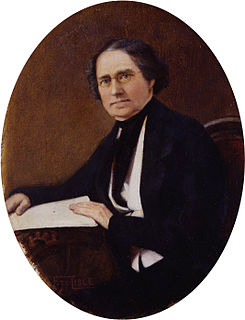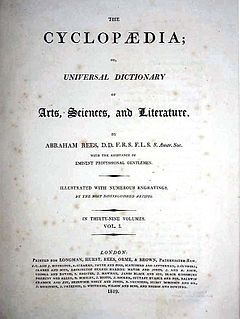Edited works
Partington edited The British Cyclopædia of Arts and Sciences, Literature, History, Geography, Law and Politics, Natural History and Biography, from 1835; the tenth and last volume appeared in 1837. [1] As a part publication, it appeared from May 1834 in monthly parts at a shilling. [7] The divisions were: [8]
- Arts and Sciences;
- Natural History;
- Biography; and
- Literature, History and Geography.
Partington wrote: division 1 parts i.–xxv., division 2 parts i.–xxiv., division 3 parts i.–xi. [1] Much of the natural history division was written by Robert Mudie. [9]
Other edited works were: [1]
- Lectures on Select Subjects in Mechanics and Hydrostatics, by J. Ferguson, F.R.S., adapted to the present state of science (1825)
- The Century of Inventions, by the Marquis of Worcester, with Notes and a Biographical Memoir (1825)
- The Mechanics' Gallery of Science and Art, 1825, vol. i.; no more printed.
Periodicals
Partington edited The Scientific Gazette, or Library of Mechanical Philosophy, Chemistry, and Discovery, which ran from July 1825 to 4 February 1826. With the civil engineer William Newton, he edited and partly wrote the second series of The London Journal of Arts and Sciences, containing descriptions of every new patent; also original communications on science and philosophy; this periodical went to nine volumes, 1834–42. [1]

Professor Dionysius Lardner FRS FRSE was an Irish scientific writer who popularised science and technology, and edited the 133-volume Cabinet Cyclopædia.

John Edward Gray, FRS was a British zoologist. He was the elder brother of zoologist George Robert Gray and son of the pharmacologist and botanist Samuel Frederick Gray (1766–1828). The standard author abbreviation J.E.Gray is used to indicate this person as the author when citing a botanical name. The same is used for a zoological name.

Rees's Cyclopædia, in full The Cyclopædia; or, Universal Dictionary of Arts, Sciences, and Literature was an important 19th-century British encyclopaedia edited by Rev. Abraham Rees (1743–1825), a Presbyterian minister and scholar who had edited previous editions of Chambers's Cyclopædia.

John Farey Jr. was an English mechanical engineering, consulting engineer and patent agent, known for his pioneering contributions in the field mechanical engineering.

Abraham Rees was a Welsh nonconformist minister, and compiler of Rees's Cyclopædia.

The Philosophical Magazine is one of the oldest scientific journals published in English. It was established by Alexander Tilloch in 1798; in 1822 Richard Taylor became joint editor and it has been published continuously by Taylor & Francis ever since.
Jones Quain was an Irish anatomist, born at Mallow. Quain was Professor of Anatomy and Physiology in the University of London. He was author of Elements of Anatomy, of which the first edition was published in 1828.
Robert Mudie (1777–1842) was a newspaper editor and author.
John Weale was an English publisher of popular scientific, architectural, engineering and educational works.

Thomas Tredgold (1788–1829) was an English engineer and author, known for his early work on railroad construction. His definition of civil engineering formed the basis of the charter of the Institution of Civil Engineers.
Philip Taylor (1786–1870) was an English civil engineer. A significant innovator of the 1820s in steam engine design, he moved abroad to become an industrial leader in France and Italy.
Henry Petrie (1768–1842) was an English antiquary and official.

Constable's Miscellany was a part publishing serial established by Archibald Constable. Three numbers made up a volume; many of the works were divided into several volumes. The price of a number was one shilling. The full series title was Constable's Miscellany of Original and Selected Publications, in the Various Departments of Literature, Science, and the Arts.
Henry David Inglis, pseudonym Derwent Conway (1795–1835) was a Scottish travel writer and journalist.
Henry Moseley was an English churchman, mathematician, and scientist.
William Jones (1762–1846) was a Welsh bookseller, religious writer, and member of the Scotch Baptist church in Finsbury, London.
The Aldersgate Medical School was a medical school in east London, in existence from about 1825 to 1848. One of many private medical schools of the period, it had popular lecturers on its staff, and proved a serious rival to St. Bartholomew's Hospital as a teaching institution.

Bartholomew Lloyd (1772–1837) was an Irish mathematician and academic whose entire career was spent at Trinity College Dublin. As Erasmus Smith's Professor of Mathematics there, he promoted significant curricular reforms, including the introduction of the teaching of calculus. Later he served as Provost of the college.
Thomas Turner Tate (1807–1888) was an English mathematical and scientific educator and writer. Largely self-taught, he has been described as "a remarkable pioneer of science and mathematics teaching".

Sir George Smith Gibbes M.D. (1771–1851) was an English physician and writer.
This page is based on this
Wikipedia article Text is available under the
CC BY-SA 4.0 license; additional terms may apply.
Images, videos and audio are available under their respective licenses.
![]() This article incorporates text from a publication now in the public domain : Lee, Sidney, ed. (1895). "Partington, Charles Frederick". Dictionary of National Biography . Vol. 43. London: Smith, Elder & Co.
This article incorporates text from a publication now in the public domain : Lee, Sidney, ed. (1895). "Partington, Charles Frederick". Dictionary of National Biography . Vol. 43. London: Smith, Elder & Co.








